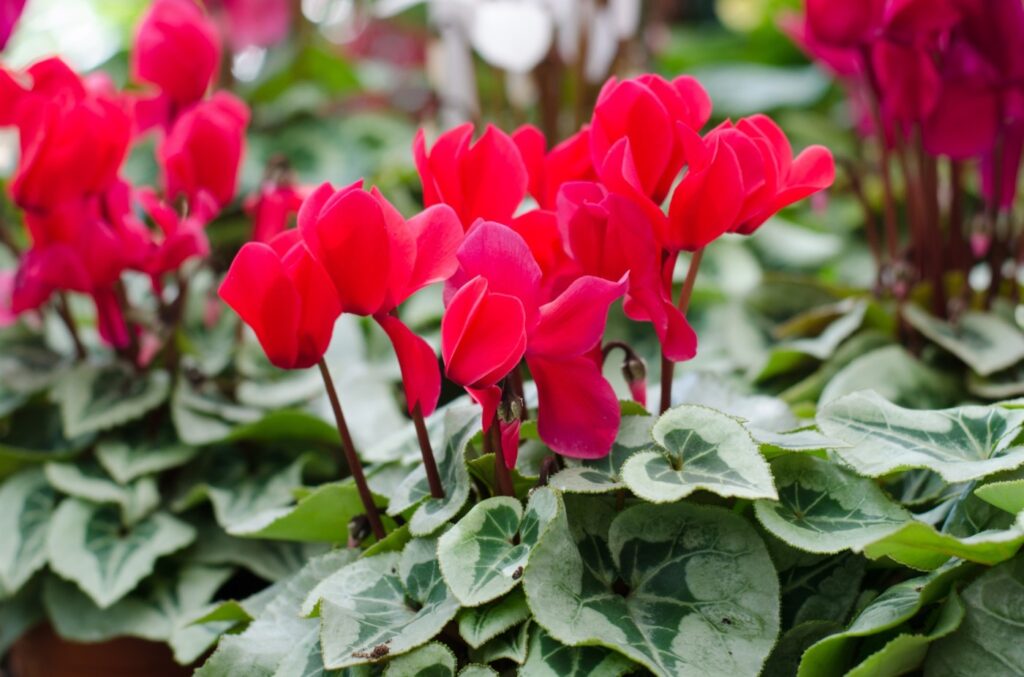
5 things to do in the garden this week:
1. If you haven’t done so by now, plant cyclamen. This is the most regaled flower of the winter months and with ample justification due to its silky flowers that resemble inverted lampshades in red, pink, purple, salmon, or white. Dwarf varieties with diminutive flowers and leaves are also available. Foliage is the other feature that makes cyclamen such a special plant. The white patterns you see on the leaves are always perfectly symmetrical but display differences from plant to plant. You can keep cyclamen alive for years if you are scrupulous about not watering the area where the plants grew once they disappear from sight after flowers fade and leaves drop off. Their circular tubers will survive and send out new leaves and flowers year after year as long as not a drop of water touches them during their long period of dormancy that lasts from early spring until fall.
2. Take root cuttings of thick-rooted plants such as bear’s breeches (Acanthus mollis), Oriental poppies (Papaver orientale), and great mullein (Verbascum thapsus). After digging up a part of a plant’s root system, detach individual roots and cut them into pieces around two inches in length. Fill plastic cells of the type used by nurseries for growing annual flowers with any potting mix and insert the root pieces vertically into the mix. Make sure that each root cutting is oriented properly, meaning the top end was closer to the crown (where stem meets roots) prior to being cut. For this reason, it’s a good idea when cutting each root piece to make a mark near its top end. If you orient the root piece incorrectly, it won’t sprout shoots.
3. Take hardwood cuttings of fig and mulberry trees, grapevines, viburnum, butterfly bushes (Buddleia), and roses of all types, although shrub roses are the easiest to propagate in this manner. Cuttings should have at least a pencil’s diameter in thickness and extend 6-12 inches in length. Cut the bottom of the cutting just below a node and dip the bottom inch of the cutting in root hormone powder, available at most nurseries or through Internet vendors. Bury the cutting so that two-thirds of its length is under the soil surface; at least two nodes should be above the surface and, once again, ascertain that the top end of the cutting is oriented as it was on the tree. Rooting might not take place for several months but the resulting tree or plant will have an excellent start as roots should have formed all along the cutting.
4. Order seeds for spring planting. One of the best sources is Seed Savers Exchange. This is a non-profit enterprise that carries the widest variety of heirloom vegetable and flower seeds available anywhere. Their mission is to preserve heirloom varieties and develop a community of gardeners who assist in this endeavor. Although you can view their seed selection online, you can also order a free catalog from the website at seedsavers.org. Furthermore, through the ADAPT program, you can test heirloom seeds in your own garden by becoming a “community scientist.” If accepted to the program, you will be sent seeds and data sheets to report your findings. To be considered for seed testing, you must apply by January 26th through the website. One participant in the program wrote as follows: “Through ADAPT, I’ve had the privilege of uncovering diverse crop varieties that I might never have discovered otherwise, some of which have become yearly staples in my garden … Now an impressive 95% of my garden consists of plants grown from seed, and the sense of accomplishment is truly exhilarating.” You want exotic? A white beet tested through the ADAPT program yielded a crop “so sweet it almost tastes like sweet corn.”
Related Articles
13 Southern California plant and garden events in 2024
How to find plants for your garden in biodegradable pots
What to prune and what to plant in the garden this week
Readers share their strategies for keeping squirrels out of their gardens
Start germinating seeds now to have them ready to plant seedlings in March
5. If you have seeds more than two years old, it is advisable to test them now for germination so you will know whether or not to plant more of the batch. Take ten seeds – or fewer if your total number of seeds for a particular crop is small – and put them with a moist paper towel in a zippered plastic bag. Place the bag in a warm spot and check on the seeds every couple of days to see if they germinate. Given proper storage – in paper envelopes in a garage, for example – most seeds remain viable for at least two years and some of them for up to five years or longer. There are charts on the Internet that list the approximate longevity for seeds of every vegetable crop.
Please send questions or comments about any plant or gardening practice, or any garden problem that comes your way to [email protected]
